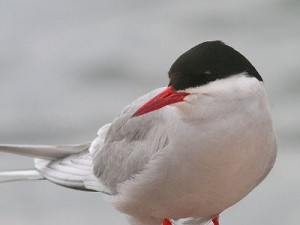Arctic Terns

The terns are nesting on all the ridges at the moment so when we are ridge walking we have be careful not to tread on their nests. When we are out on the boat they swoop around us sometimes following us for a ways. The other day we watched one try to take on a Skua – everyone was routing for the little fella. They are very hard to get pictures of due to their speed of movement.
A few days ago BAS sent out a press release about a paper that confirms they have the longest animal migration in the world. New information on bird migration was revealed by an international team of scientists who confirmed that the Arctic tern flies more than 70,000 km on its annual migration trip from pole to pole — the equivalent of three trips to the moon and back over its lifetime. Scientists were able to map the migratory movements using the tiny tracking instrument known as a geolocator, which was developed by BAS scientists.
This simplified figure shows migration patterns of the Arctic tern, from the breeding sites in Greenland and Iceland to the winter grounds at Antarctica. After initiating the southbound migration (yellow line) the birds pause their migration in the central part of the North Atlantic (small circle) for almost a month before they continue towards the wintering sites at Antarctica (large circle). In spring, the northbound migration (white line) is conducted more than twice as fast in a gigantic ‘S’ shaped pattern through the Atlantic Ocean. Areas particularly rich in biological productivity are indicated by yellow and green colours.
I mentioned this in the dive boat and of course the marine biologists had lots of smart allack comments on how could a bird fly where there was no oxygen etc. but everyone did agree that it was a pretty amazing and hard to comprehend – those little birds have seen a lot!
3 Responses to “Arctic Terns”
-
Suzanne Smith January 24th, 2010 at 8:58 am
Loved the story about the tern and its ability to fly long distances. I seem to remember our expedition leader on the Polar Star telling us that the wandering albatross can be at sea for 7 years and never touch ground- just rest on the waves when needed! Wow!
Ashlye. Harry and I love your blog!
-
I heard about these on NPR last week!
Loving your blog! – Nice and wet here in California.
J
-
Annie Hughes must not be reading this week or she would be bound to be fascinated, off to the packing, could learn from these birds speed and stamina wise x mum

